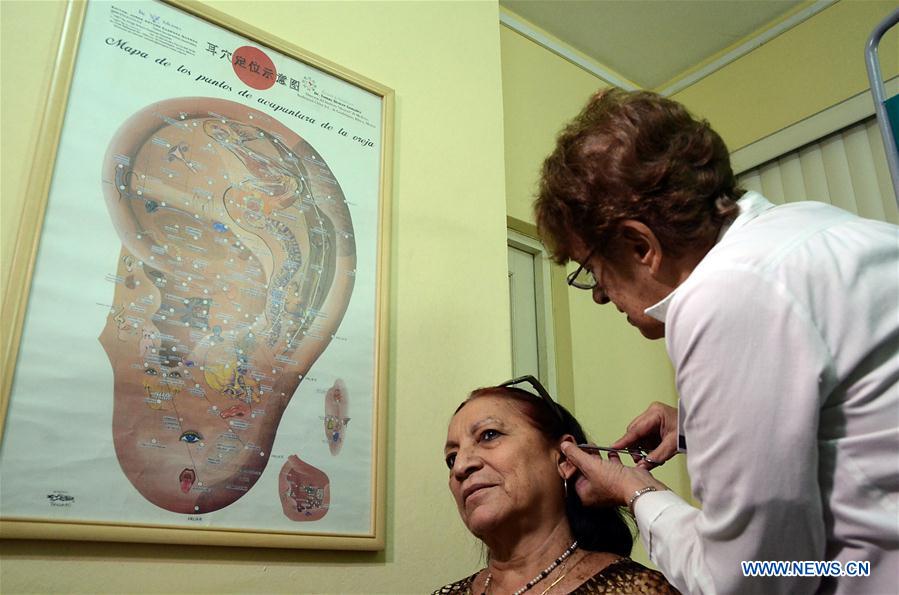
Image taken on March 2, 2017 shows a doctor applying a natural and traditional Chinese medicine treatment on a patient at the Gastroenterology Institute in Havana, Cuba. Over the last 20 years, traditional Chinese medicine (TCM) has been gaining ground in Cuba as a new way of easing ailments and treating chronic pains and diseases. Cubans have since the 1990s benefited from TCM, whose ancient roots have deepened in the island's awareness without the need to conduct publicity campaigns. (Xinhua/Joaquin Hernandez)
HAVANA, April 22 (Xinhua) -- Over the last 20 years, traditional Chinese medicine (TCM) has been gaining ground in Cuba as a new way of easing ailments and treating chronic pains and diseases.
Cubans have since the 1990s benefited from TCM, whose ancient roots have deepened in the island's awareness without the need to conduct publicity campaigns.
GOOD TREATMENT EFFECTS ARE WALKING ADVERTISEMENTS
"I saw the effects in other patients. Therefore I went to a local clinic for treatment and the results have been very favorable," Marta Gonzalez told Xinhua.
At 77 years of age and diagnosed with osteoarthritis, Marta said that after a few courses of treatment using suction cups and moxibustion -- a therapy which involves burning dried mugwort on the body's particular points, her pains almost disappeared.
Just like her, Rigoberto Villalza came to Havana's Camilo Cienfuegos primary care center in search of a better quality of life free from years of sufferings from two herniated discs in his spinal cord.
"They treated me with ozone and acupuncture and I've noticed considerable relief. Also with these treatments, I am avoiding surgery, which is very traumatic," he noted.
In addition to targeting ailments associated with joint pains, Cuba applies traditional and natural medicine to other health conditions.
Diana Guillen has treated thousands of patients over the years and was one of the first TCM specialists on the Caribbean island.
"This rehab center is always full because favorable results have been obtained over time. We always make an initial diagnosis through an exhaustive questionnaire and a physical examination to determine the best treatment for each case," she said.
Although most of her patients are elderly, Guillen is also very satisfied with treating other conditions such as chronic asthma, gastric ulcer or high blood pressure with TCM.
"What we do is to raise the quality of life of the population and we start each treatment with that expectation. What fulfills us most as doctors is that results can be seen in a short time," she said.
In Cuba, family doctors are able to provide such treatments while polyclinics are mostly better equipped. A number of hospitals and research institutes have both TCM and specialized doctors to treat specific disorders with a range of therapies.
This is the case with the Institute of Neurology and Neurosurgery and the Institute of Gastroenterology, both based in the capital Havana.
Working with the Institute of Gastroenterology, Mirna Quintero is a pioneer in treating digestive disorders with TCM.
"At the beginning, I was alone and started doing acupuncture and its related techniques, then years later others were introduced. Recently we have incorporated laser therapy and drug puncture," she said.
Currently, said Quintero, the institute's research protocols include treatments which have shown positive results and great acceptance by patients who are interested in such techniques previously unknown but praised today by many.
TCM HISTORY IN CUBA
Cuban doctors first learned TCM from Chinese professionals through a program that began in 1995, when this discipline was included in the national curriculum of medical studies.
International cooperation has since been a key factor in developing this medical program over the years.
"In the 1990s, we had an exchange with Chinese, Vietnamese and North Korean advisers to fully implement the program. Many of the doctors trained in those years received classes directly from Chinese professors," Johann Perdomo, head of the department of natural and traditional medicine of the Cuban Ministry of Health (MINSAP), told Xinhua.
Later on, he added, there has been cooperation with different Asian nations to bring to Cuba herbs and plants for traditional medicine treatments.
The development of traditional and natural medicine is also part of a comprehensive program involving MINSAP, as well as other government agencies.
According to Perdomo, such medical treatments began as a necessity due to the deep economic crisis the island faced after the collapse of the Soviet Union.
"It was a good and cheap way to solve some of the most important health issues of our population at the time while maintaining a universal and free healthcare system," he said.
However, realities have changed dramatically with natural and traditional medicine now being firmly integrated into the Cuban health system after more than 20 years of sustained application.
By 2016, more than 200 Cuban doctors had graduated as specialists in traditional and natural medicine, allowing the island to open more healthcare centers.
The service is also complemented by the use of 144 natural medicine products, most of which are made at local centers while others by pharmaceutical factories.
"Some have been registered and patented in different countries while we currently export others. One example is Vidatox, whose principal ingredient is obtained from the venom of the blue scorpion to treat cancer patients," said Perdomo.
Other examples include Abexol, an extract drawn from beeswax, and Policosanol (PPG), a mixture of aliphatic alcohols isolated from sugarcane for reducing cholesterol and treating osteoporosis.
The practice of TCM is so successful in Cuba that the government has integrated it into a plan to promote health tourism, seeking to attract foreign visitors for chronic diseases and ailments treatment here.















